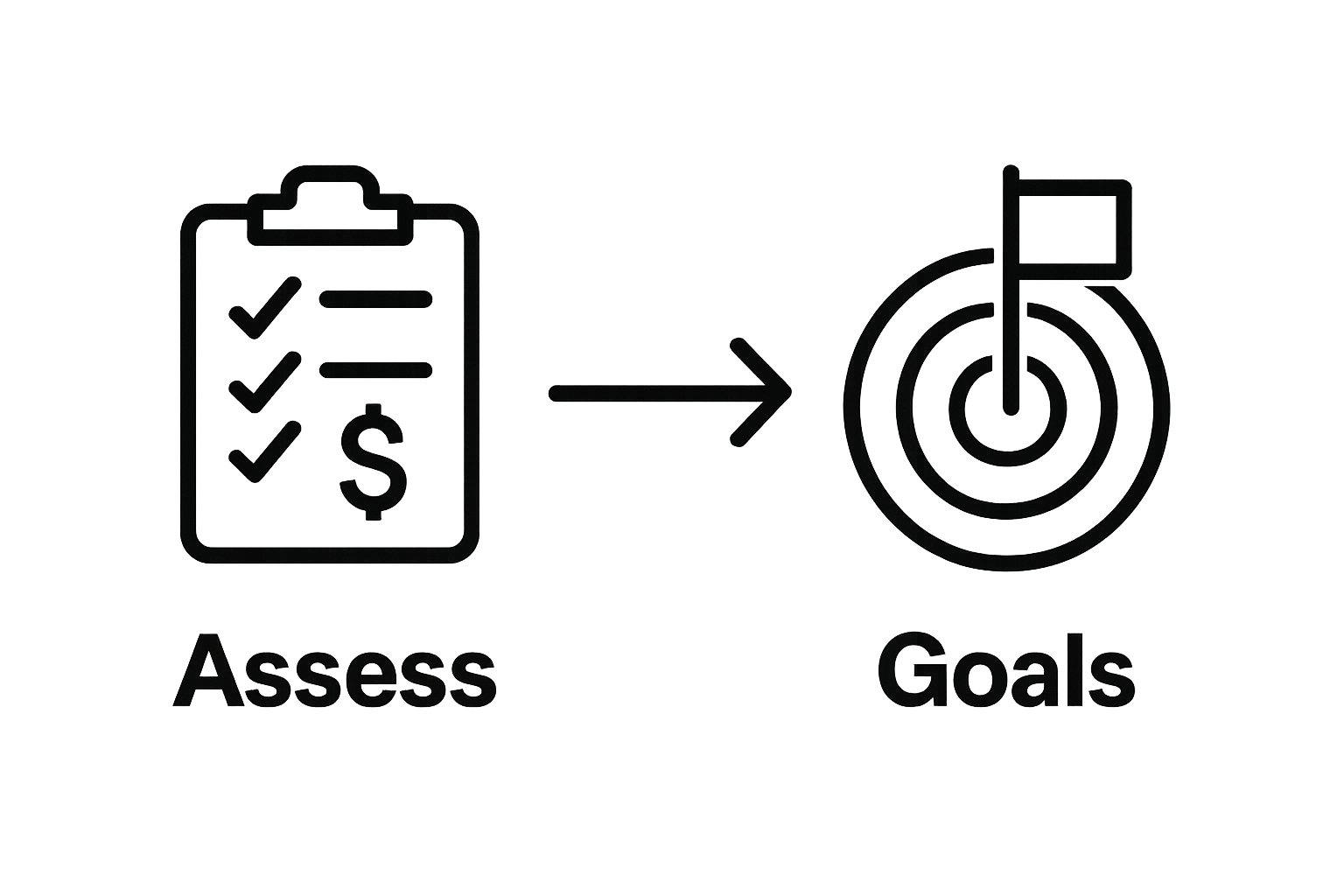Estate planning often sounds like something only the ultra-wealthy need to worry about. But the reality is that every adult should have an estate plan in place, and fewer than 34 percent of Americans actually do. Most are surprised to find out that making a solid estate plan can be much more straightforward than expected. Secrets like digital document tools and family conversations quickly turn what feels overwhelming into a process anyone can master.
Table of Contents
- Step 1: Assess Your Current Financial Situation
- Step 2: Identify Key Estate Planning Goals
- Step 3: Gather Necessary Legal and Financial Documents
- Step 4: Develop and Outline Your Estate Plan
- Step 5: Review, Finalize, and Execute Your Estate Plan
- Step 6: Regularly Update and Monitor Your Estate Plan
Quick Summary
| Key Point | Explanation |
|---|---|
| 1. Assess your financial situation first | Gather and organize all financial documents to understand your assets and liabilities before estate planning. |
| 2. Define clear estate planning goals | Create specific, meaningful goals for preserving wealth and ensuring family security which reflect your values. |
| 3. Gather legal and financial documents | Collect essential documents, including wills, trusts, and personal records for a comprehensive estate plan. |
| 4. Develop a strategic estate plan | Create a detailed, actionable estate plan using the gathered information to protect assets and fulfill your goals. |
| 5. Regularly update your estate plan | Review and adjust your estate plan every few years or after significant life events to remain relevant and effective. |
Step 1: Assess Your Current Financial Situation
Launching an effective estate planning workflow begins with a comprehensive assessment of your current financial landscape. This crucial first step provides the foundational blueprint for developing a strategic and personalized estate plan that protects your assets and secures your family’s financial future.
Starting your estate planning workflow requires a meticulous examination of your complete financial ecosystem. This means gathering and organizing all critical financial documents that paint a holistic picture of your wealth. Comprehensive documentation includes tax returns, bank statements, investment portfolios, retirement accounts, life insurance policies, property deeds, business ownership records, and any existing estate planning documents.
Begin by creating a detailed inventory of your assets and liabilities. This process involves more than simply listing bank balances. You will need to calculate your net worth by comprehensively documenting all tangible and intangible assets. This includes real estate holdings, investment accounts, retirement savings, business interests, valuable personal property like artwork or collectibles, and any outstanding debts or financial obligations.
According to Estate Planning Professionals Association, successful estate planning requires a granular understanding of your financial position. Professional financial advisors recommend conducting this assessment annually to ensure your estate plan remains current and aligned with your evolving financial circumstances.
While compiling this information might seem overwhelming, breaking the process into systematic steps can simplify the workflow. Consider using digital financial management tools or working with a professional who can help streamline document collection and organization. The goal is creating a comprehensive financial snapshot that will inform every subsequent decision in your estate planning journey.
Key verification criteria that indicate you have successfully completed this step include:
- A comprehensive spreadsheet detailing all assets and their estimated current value
- Copies of all critical financial documents organized in a secure, accessible location
- A clear understanding of your current net worth and financial positioning
By meticulously assessing your current financial situation, you establish a solid foundation for developing a robust and responsive estate planning strategy that adapts to your unique wealth management needs.
Step 2: Identify Key Estate Planning Goals
After thoroughly assessing your financial landscape, the next critical phase in your estate planning workflow involves clearly defining your specific estate planning objectives. This step transforms your financial inventory into a purposeful strategy that reflects your personal values, family dynamics, and long term wealth preservation intentions.
Estate planning goals are deeply personal and extend far beyond simple asset distribution. Your objectives might include providing financial security for your spouse and children, minimizing potential tax liabilities, establishing philanthropic legacies, protecting family businesses, or ensuring smooth generational wealth transfer. The key is crafting goals that are both emotionally meaningful and financially pragmatic.
Begin by conducting an honest family discussion about wealth transfer expectations and potential scenarios. Consider potential life transitions such as retirement, potential healthcare needs, supporting dependent family members, and protecting vulnerable beneficiaries. This conversation helps create alignment and prevents future misunderstandings that could potentially create family conflicts.
According to the IRS Estate and Gift Tax Guidelines, effective estate planning requires anticipating complex family and financial dynamics. This means thinking beyond immediate financial distributions and considering long term implications of your wealth transfer strategy.
Your estate planning goals should address multiple dimensions of wealth preservation and transfer. Some individuals prioritize minimizing estate taxes, while others focus on creating educational trusts for grandchildren or establishing charitable foundations. Some may want to protect family businesses, ensuring smooth leadership transitions and maintaining operational continuity.
Key verification criteria that indicate you have successfully completed this step include:
- A written document clearly articulating your primary estate planning objectives
- Consensus among family members about wealth transfer expectations
- Preliminary identification of potential strategies to achieve your defined goals
By meticulously identifying and documenting your estate planning goals, you create a roadmap that transforms your financial assets into a meaningful legacy that reflects your values and protects your family’s future.

Step 3: Gather Necessary Legal and Financial Documents
Transitioning from identifying your estate planning goals, the next critical step in your estate planning workflow involves systematically collecting and organizing the legal and financial documents that will form the backbone of your comprehensive estate plan. This process requires meticulous attention to detail and a strategic approach to document management.
Comprehensive document gathering goes beyond simply collecting paperwork. You are creating a detailed financial and legal narrative that will guide your estate planning strategy. Start by creating a secure, organized system for storing both physical and digital copies of critical documents. Consider using a fireproof and waterproof home safe or a secure digital cloud storage solution with robust encryption to protect sensitive information.
The documentation process requires collecting an extensive range of personal, financial, and legal records. This includes birth certificates, marriage licenses, social security cards, passport copies, property deeds, vehicle titles, investment account statements, retirement account documentation, life insurance policies, business ownership records, and any existing will or trust documents. Each document serves as a critical piece of your overall estate planning puzzle.
According to Legal Professionals Association, maintaining a comprehensive and up-to-date document collection is fundamental to effective estate planning. Professional legal advisors recommend creating both physical and digital backup copies to ensure documents remain accessible and protected against potential loss or damage.
Pay special attention to financial account information, including account numbers, financial institution contact details, and beneficiary designations. Gather documentation for all bank accounts, investment portfolios, retirement accounts, and insurance policies. Include information about digital assets such as cryptocurrency holdings, online financial accounts, and digital storage platforms that might contain valuable information or assets.
Key verification criteria that indicate you have successfully completed this step include:
- A comprehensive, organized file containing all critical personal and financial documents
- Digital and physical backup copies of essential records
- A secure storage system that protects sensitive information
By meticulously gathering and organizing your legal and financial documents, you create a solid foundation for a robust and comprehensive estate planning workflow that provides clarity and protection for your financial legacy.
Step 4: Develop and Outline Your Estate Plan
With your financial documents gathered and goals clearly defined, the next pivotal stage in your estate planning workflow involves developing a comprehensive and strategic estate plan that translates your intentions into actionable legal frameworks. This step transforms your financial vision into a structured blueprint that protects your assets and provides clear guidance for your family’s future.
Developing an estate plan requires a holistic approach that balances legal precision with personal values. Begin by determining the most appropriate legal instruments to achieve your specific objectives. This might include creating a last will and testament, establishing revocable or irrevocable trusts, setting up power of attorney designations, and developing advanced healthcare directives. Each document serves a distinct purpose in protecting your assets and ensuring your wishes are respected.
Consider the unique dynamics of your family and financial situation when structuring your estate plan. This means thoughtfully selecting executors, trustees, and guardians who not only have the legal capacity to manage your affairs but also share your values and understand your family’s specific needs. The individuals you choose will play a critical role in implementing your estate planning strategy, so select them with careful consideration.
According to the National Conference of State Legislators, effective estate planning involves anticipating potential scenarios and creating flexible legal mechanisms that can adapt to changing family and financial circumstances. This might include establishing contingency plans that address potential challenges such as minor children’s care, business succession, or management of complex asset portfolios.
Your estate plan should also incorporate tax optimization strategies that minimize potential estate tax liabilities while maximizing the value transferred to your beneficiaries. This requires a nuanced understanding of current tax laws and potential future regulatory changes. Professional financial advisors can provide valuable insights into structuring your estate to achieve maximum tax efficiency.
Key verification criteria that indicate you have successfully completed this step include:
- A comprehensive draft of your estate planning documents
- Clear identification of key legal representatives and decision makers
- Preliminary tax optimization strategies integrated into your plan
By methodically developing and outlining your estate plan, you create a robust legal framework that provides clarity, protection, and peace of mind for you and your loved ones.

Step 5: Review, Finalize, and Execute Your Estate Plan
The culmination of your estate planning workflow arrives with a critical phase of review, finalization, and execution. This step transforms your carefully crafted documents from theoretical plans into legally binding instruments that will protect your legacy and provide clear guidance for your family’s financial future.
Comprehensive review requires a multifaceted approach that examines your estate plan from legal, financial, and personal perspectives. Begin by conducting a thorough line-by-line review of all estate planning documents with a professional estate planning attorney or financial advisor. This collaborative review ensures that every clause, designation, and instruction precisely reflects your intended goals and aligns with current legal requirements.
Schedule a comprehensive family meeting to discuss the details of your estate plan. This transparent approach allows your designated representatives, potential beneficiaries, and key family members to understand your intentions, ask questions, and provide input. Open communication prevents potential misunderstandings and reduces the likelihood of future conflicts that could challenge your estate plan’s execution.
According to the American College of Trust and Estate Counsel, successful estate plan execution requires more than just legal documentation. It demands a holistic strategy that considers potential future scenarios, tax implications, and the evolving needs of your family and beneficiaries.
Ensure all legal documents are properly signed, witnessed, and notarized according to your state’s specific legal requirements. This includes your will, trust documents, power of attorney designations, healthcare directives, and any additional estate planning instruments. Store original signed documents in a secure, fireproof location and provide copies to key representatives and advisors.
Key verification criteria that indicate you have successfully completed this step include:
- All estate planning documents are professionally reviewed and legally executed
- Key family members and representatives understand the estate plan’s details
- Original documents are securely stored with accessible backup copies
- Designated representatives have been informed of their roles and responsibilities
By meticulously reviewing, finalizing, and executing your estate plan, you create a robust legal framework that provides clarity, protection, and peace of mind for you and your loved ones.
Step 6: Regularly Update and Monitor Your Estate Plan
The final and ongoing phase of your estate planning workflow involves consistent monitoring and periodic updating of your estate plan. This critical step ensures that your carefully crafted legal documents remain relevant, effective, and aligned with your evolving financial circumstances, family dynamics, and legal landscape.
Estate planning is not a one time event but a dynamic, continuous process that requires proactive management. Establish a systematic approach to reviewing your estate plan at least every three to five years, or immediately following significant life events such as marriages, divorces, births, deaths, substantial changes in financial status, or major asset acquisitions. These trigger points demand a comprehensive reassessment of your existing estate planning strategy.
Create a personal tracking system that helps you monitor potential changes requiring estate plan updates. This might involve setting calendar reminders, establishing an annual financial review with your advisor, or developing a checklist of life events that could impact your estate planning documents. Consider maintaining a digital or physical folder where you can collect relevant documentation and notes about potential modifications throughout the year.
According to the Internal Revenue Service Estate Planning Guidelines, staying informed about changes in tax laws, inheritance regulations, and financial strategies is crucial for maintaining an effective estate plan. Professional financial advisors recommend remaining adaptable and willing to make strategic adjustments as your personal and financial landscapes evolve.
Pay special attention to changes in federal and state tax laws that might impact your estate’s tax liabilities. This includes monitoring estate tax exemption limits, gift tax regulations, and potential legislative changes that could affect your wealth transfer strategies. Consulting with a tax professional or estate planning attorney can help you navigate these complex regulatory environments.
Key verification criteria that indicate you have successfully completed this step include:
- Established a regular review schedule for your estate planning documents
- Created a systematic method for tracking potential update triggers
- Maintained open communication with financial and legal advisors
- Developed a flexible approach to modifying your estate plan as needed
By consistently updating and monitoring your estate plan, you ensure that your legal documents remain a powerful, responsive tool for protecting your financial legacy and supporting your family’s long term financial security.
The following checklist table summarizes the key verification criteria you should meet to confirm completion of each major estate planning workflow step.
| Workflow Step | Completion Criteria |
|---|---|
| Assess Current Financial Situation | Spreadsheet of assets, organized financial documents, clear net worth |
| Identify Estate Planning Goals | Written objectives, family consensus, preliminary strategies identified |
| Gather Legal and Financial Documents | Comprehensive, organized file; backups; secure storage system |
| Develop and Outline Estate Plan | Draft documents, identified legal representatives, preliminary tax strategies |
| Review, Finalize, and Execute Estate Plan | Documents reviewed/executed, family informed, originals stored securely |
| Regularly Update and Monitor Estate Plan | Regular review schedule, tracking system, advisor communication, flexibility |
Take Your Estate Planning from Checklist to Action—Partner with Future Family Office
You have carefully mapped every step of your estate planning workflow, from assessing assets and organizing documents to clarifying your legacy goals. Still, the process can feel overwhelming, especially as your wealth grows or your family’s needs evolve. Uncertainty about staying organized, meeting regulatory demands, and connecting with expert guidance can create stress, even for the most diligent planners.

It is time to transform your estate planning strategy into enduring peace of mind. Discover the collective power of the Future Family Office community. As a member, you can access a robust directory of service providers, up-to-date resources, and connect with experienced professionals who share their real-world insights. Do not wait until next year’s review—start strengthening your financial legacy today. Join Future Family Office to make your plan work for you and your loved ones now.
Frequently Asked Questions
What is the first step in the estate planning workflow?
The first step involves assessing your current financial situation by gathering and organizing all critical financial documents, creating a comprehensive inventory of your assets and liabilities, and calculating your net worth.
Why is it important to identify key estate planning goals?
Identifying your estate planning goals helps to translate your financial inventory into a purposeful strategy that is aligned with your personal values, family dynamics, and intentions for wealth preservation and distribution.
What types of legal documents should be gathered for estate planning?
You should gather a range of legal documents including a last will and testament, trusts, power of attorney designations, healthcare directives, and personal identification records like birth certificates and social security cards.
How often should I review and update my estate plan?
It’s advisable to review and update your estate plan at least every three to five years, or immediately following significant life events such as marriages, divorces, births, or major changes in financial status.
Recommended
- Family Office Succession 2025: How Next-Gen Heirs Are Turning Wealth Into Impact – Future Family Office
- Lauren Lanphear: How Can You Protect a Living Legacy? – Future Family Office
- How can we Prepare the Now Generation of Family Business? – Future Family Office
- How can we Prepare the Now Generation of Family Business? – Future Family Office




